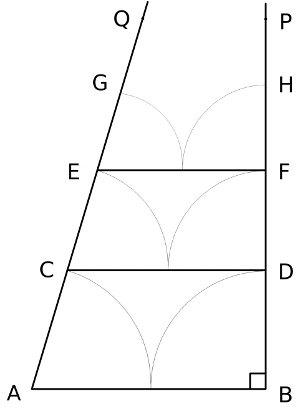
A paradox attributed to Proclus Lycaeus (412-485):
Consider two nonparallel lines, AQ and BP. BP is perpendicular to AB; AQ isn’t. Find the midpoint of AB and mark AC = BD = AB/2. Now if AQ and BP are going to intersect, it can’t happen on AC or BD; if it did, say at a point R, then that would give us a triangle ARB where the sum AR + RB < AB, which is impossible. But now we can connect CD and follow the same process: CE and DF can't intersect for the same reason. EG and FH are likewise ruled out, and so on up the line forever. This seems to mean that two nonparallel lines will never intersect. That can’t be right, but where is the error?
(From Alfred Posamentier, Magnificent Mistakes in Mathematics, 2013.)
